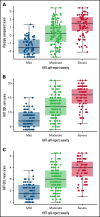Development and performance of a hereditary hemorrhagic telangiectasia-specific quality-of-life instrument
- PMID: 35877137
- PMCID: PMC9327531
- DOI: 10.1182/bloodadvances.2022007748
Development and performance of a hereditary hemorrhagic telangiectasia-specific quality-of-life instrument
Abstract
Hereditary hemorrhagic telangiectasia (HHT) is characterized by arteriovenous malformations and telangiectasia, with primary clinical manifestations of epistaxis and gastrointestinal bleeding and resultant anemia. HHT negatively affects health-related quality of life (HR-QoL); however, existing tools to measure HR-QoL are not HHT specific. Our objective was to develop an HHT-specific HR-QoL (HHT-QoL) instrument and evaluate its performance in a cross-sectional survey of individuals with HHT. Four HHT-specific questions were developed to evaluate the impact of HHT on productivity and social and personal interactions. An anonymous e-mail survey was conducted through Cure HHT. Participants also indicated their perceived HHT severity and completed 3 Patient-Reported Outcomes Measurement Information System (PROMIS) questionnaires: Discretionary Social Activities, Social Roles, and Emotional Distress. Complete data were available for 290 participants who self-identified their HHT severity as mild (29%), moderate (46%), or severe (25%). The HHT-QoL scale was reliable (Cronbach's-α, 0.83). Principal components analysis indicated the instrument was unidimensional. Participants had low levels of QoL with their ability to participate in discretionary social activities (PROMIS mean 36.4 [standard deviation 14.3]) and perform in social roles (41.5 [17.2]), and the presence of a high level of emotional distress (64.8 [24.2]). The HHT-QoL score correlated negatively with PROMIS Discretionary Social Activities (r = -0.65) and Social Roles (r = -0.68) and positively correlated with PROMIS Emotional Distress (r = 0.51). In conclusion, the 4-item HHT-QoL instrument provides valuable insight and may be a useful addition to future clinical research in HHT.
© 2022 by The American Society of Hematology. Licensed under Creative Commons Attribution-NonCommercial-NoDerivatives 4.0 International (CC BY-NC-ND 4.0), permitting only noncommercial, nonderivative use with attribution. All other rights reserved.
Figures






References
-
- McDonald J, Bayrak-Toydemir P, Pyeritz RE. Hereditary hemorrhagic telangiectasia: an overview of diagnosis, management, and pathogenesis. Genet Med. 2011;13(7):607-616. - PubMed
-
- Dupuis-Girod S, Bailly S, Plauchu H. Hereditary hemorrhagic telangiectasia: from molecular biology to patient care. J Thromb Haemost. 2010;8(7):1447-1456. - PubMed

